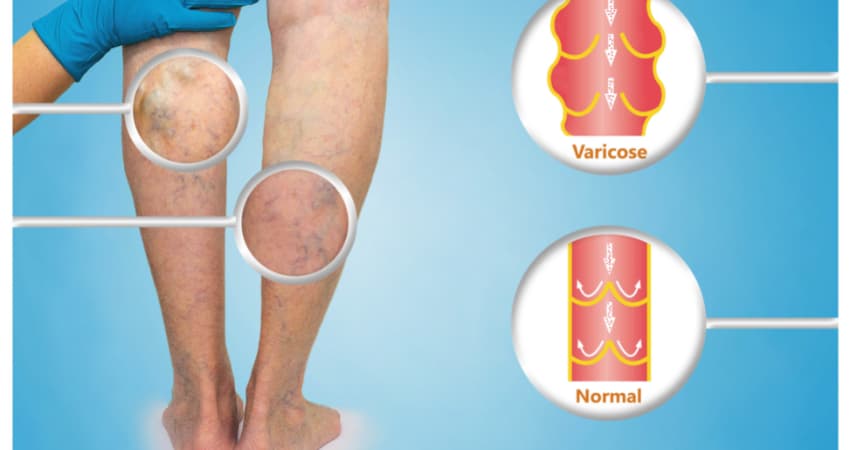Blood circulation can be greatly impacted by varicose veins, which can lead to discomfort and possible health problems. These twisted, swollen veins are commonly found in the legs, where they hinder the heart’s ability to pump blood efficiently. Vein valves normally control the flow of blood, but when a valve is compromised, blood can pool and cause varicose veins.
The quality of life and everyday activities may be negatively impacted on the veins which include discomfort, edoema, and heaviness. Moreover, varicose veins can worsen if left untreated and result in problems like blood clots or ulceration. Therefore, in this piece of writing, we’ll describe that how varicose veins affect blood circulation. So, stay with us here and keep reading below.
Top 6 Ways Varicose Veins Affect Blood Circulation
Varicose veins might indicate underlying problems with your vascular system, so they’re not only an aesthetic worry. Many health issues, including impaired blood circulation, can result from these twisted, enlarged veins, which are typically found in the legs. To manage and avoid issues, it is crucial to know how varicose veins impact blood flow. Therefore, in this blog post, we’ll highlight the top 6 ways varicose veins affect blood circulation. So, dig deeper into this article to reveal the notion.
1. Impaired Venous Return
The main cause of varicose veins is faulty venous valves. These valves normally make sure that blood only flows in one direction, which is towards the heart. Blood can pool in veins, especially in the legs, when these valves malfunction because of gravity.
When blood is not successfully returned to the heart, it is referred to as venous insufficiency. Leg discomfort, edoema, and exhaustion are among the symptoms that follow from this reduced blood circulation. If you are struggling by these symptoms then you must get varicose and spider veins treatment in Dubai to get rid of the other health issues.
2. Increased Venous Pressure
The pressure inside varicose veins rises when blood accumulates there. Venous hypertension is a disorder that can worsen varicose vein symptoms and cause other circulation issues. Edoema (swelling) is the result of the increased pressure forcing fluids out of the veins and into the surrounding tissues. It also disrupts regular blood flow, which makes it harder for the body to return blood to the heart in an effective manner, which has an impact on circulation as a whole.
3. Reduced Oxygen Delivery
To provide oxygen and nourishment to the body’s tissues, a healthy blood circulation system is necessary. Slowing down the blood’s return to the heart is one way varicose veins disrupt this process.
Because of this, blood circulation becomes less effective generally, which may make it more difficult for the legs and other afflicted areas to receive oxygen. Decreased oxygen delivery can result in tissues losing vital nutrients, which can cause exhaustion, cramping in the muscles, and heaviness in the legs.
4. Formation of Blood Clots
The varicose veins can raise the risk of blood clot formation, especially deep vein thrombosis (DVT). The combination of slow blood flow and elevated vein pressure can facilitate the formation of clots. If a clot develops in a deep vein, there is a significant risk to health as it may cause complications like a pulmonary embolism if the clot moves and enters the lung.
In extreme situations, they may completely stop blood flow, posing a risk to life. Consequently, it’s critical to keep an eye on varicose veins and to get medical help if any signs, including abrupt leg pain or swelling, appear.
5. Venous Ulcers and Skin Changes
Varicose veins linked to chronic venous insufficiency can cause skin abnormalities and venous ulcers to occur. Fluid and blood cells seep into the surrounding tissues as a result of the veins’ poor circulation and elevated pressure. This might cause skin irritation, discolouration, and eventually the skin’s deterioration, which would cause excruciating ulcers.
Due to the reduced blood flow in the affected area, venous ulcers frequently take a long time to heal. The distribution of oxygen and nutrients required for wound healing is hampered by inadequate circulation. If left untreated, these ulcers have the potential to worsen and become chronic, necessitating continuous medical attention.
6. Impact on Overall Cardiovascular Health
Erythema, or severe leg swelling, is a possible consequence of varicose veins. Blood pools due to malfunctioning venous valves, which raises pressure and allows fluid to seep into the surrounding tissues. Significant health issues, such as an elevated risk of cardiovascular disorders like hypertension and heart failure, can result from chronic venous insufficiency.
To lower the risk of these serious illnesses and preserve general cardiovascular health, proper management of varicose veins and circulatory health is crucial. This causes swelling, which if left unchecked can be painful and result in more problems. Therefore, you can take varicose treatment to effectively your spider veins.
Get Ready to Treat Your Varicose Veins
Varicose veins can have a substantial influence on blood circulation and general health, making them more than just a cosmetic issue. People can take proactive measures to manage and lessen the impact of varicose veins by being aware of how they affect circulation. Improving vein health and upholding healthy circulation habits can improve general health and quality of life.
Read more: Winter Skincare: Keeping Your Skin Warm and Protected










